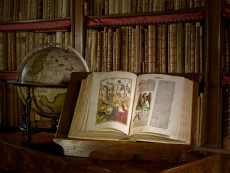ANGELICA LIBRARY
municipality: ROMA
Province: Roma
Typology:
Available for:
see: Vanvitellian Salon; Angelica Gallery.

The first news of a library at the convent of S. Agostino dates back to the early fourteenth century, but the history of Angelica begins with Angelo Rocca (1545-1620), the Augustinian bishop who, in the last years of the sixteenth century, entrusted his collection of about 20,000 volumes at the Augustinian convent. Is born so in Rome the first public library in Europe, a contested primacy with the Bodleiana of Oxford and with the Ambrosiana of Milan. Responsible for the Vatican typography during the pontificate of Sixtus V, Rocca assigned? to the library a suitable location within the Augustinian convent and, with a truly pioneering intuition for the time, decided to open it to everyone without census limits. The absolute novelty? of the institution desired by the Rocca dest? the interest of an ever growing public and the reputation of the library soon spread among scholars of the time attracting other precious legacies. In 1762 the rich library of Cardinal Domenico Passionei was purchased. Does he enrich? and double? the patrimony of Angelica with the books he had researched and purchased during his travels in the countries of Protestant Europe in quality? of papal legate. These works constitute one of the largest collections of texts on religious controversies of the seventeenth and eighteenth centuries. A few years after the acquisition of the imposing collection that belonged to the Passionei, the renovation and extension works of the rooms of the Library that the Augustinians had entrusted to the architect Luigi Vanvitelli were completed. The Augustinian history of Angelica ends after the capture of Rome, when, in March 1871, the Ecclesiastical Axis Liquidating Board issued a decree that received the assets and revenues of religious orders. On 29 December 1873 the first lay director, Ettore Novelli, was appointed. Angelica has a vast heritage, from literature to science, from esotericism to religion, from travel books to maps, medical books and Rome guides. Over 200,000 volumes make up his book heritage, of which more of 100,000 published from the 15th to the 18th century. "Location" of exception, the Angelica? it was also the scene of important "cult" films that make up the history of cinema, from the "Giardino dei Finzi Contini" by Vittorio De Sica to the pi? recent "Angels and Demons" by Ron Howard, in which the scenes set in the Vatican Library for the sake of script have been entirely shot in the spaces of Angelica.







 i
i